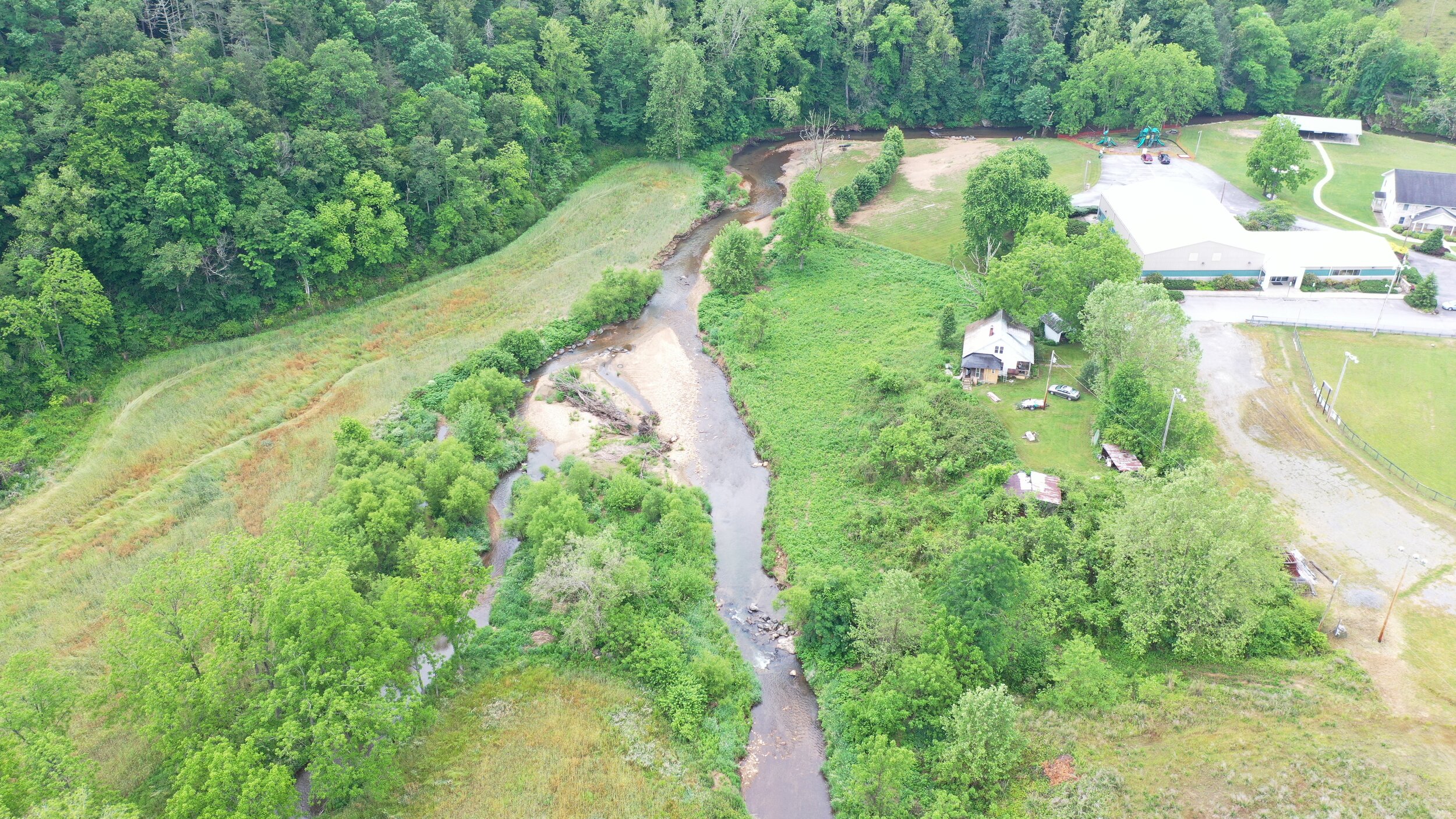The confluence of California, Paint Fork, and Little Ivy Creek immediately after construction and before riparian planting. This site is near the Beech Glen Community Center and the Beech Glen Baptist Church, Mars Hill, North Carolina. Drone photo by North State Environmental.
Mars Hill, NC
The Mars Hill Community and several partners recently restored and stabilized sections of California, Paint Fork, and Little Ivy Creek. The project remediated severely eroding streambanks and will help mitigate downstream flooding by reducing the excess sediment in the stream corridor. The project will also enhance fishing and other recreational opportunities on Little Ivey Creek. The project is located near the Beech Glen Community Center and the Beech Glen Baptist Church. Stop by the Beech Glen Community Center for an excellent view of the project.
The confluence of California, Paint Fork, and Little Ivy Creek just before the stream restoration project began. This site is near the Beech Glen Community Center and the Beech Glen Baptist Church, Mars Hill, North Carolina. Drone photo by North State Environmental.
What happened to California, Paint Fork, and Little Ivy Creek Watershed? One landowner, Clifton Metcalf, realized that severe stream erosion and flooding were hurting all three creeks. He consulted with USDA NRCS, who put him in touch with the nonprofit Resource Institute. Resource Institute, based in Winston-Salem, restores streams, rivers, and wetlands.
Resource Institute worked with other experts to assess the problem. The analysis showed the watershed significantly changed due to the development and construction of two highway projects. The increase in impervious surfaces caused a significant increase in runoff going into the streams during rain events. The unstable streams were unable to handle the increased runoff. The escalation in flow and sediment magnified the eroding the streambanks that were already severely damaged from Hurricanes Frances and Ivan, caused flooding and significant land loss for the landowners.
Resource Institute recommended restoring sections of California Creek, Paint Fork, and Little Ivy Creek. The design and engineering plans used Natural Channel Design Methodology (NCD) to stabilize the streams and halt further erosion. This restoration approach uses sustainable river engineering technologies to improve natural stream stability and habitat. The plan also called for an enhanced riparian buffer with native plants to aid in future erosion prevention and create aquatic and wildlife habitat.
Resource Institute has used NCD Methodology to restore over 1.4 million feet of stream in North Carolina. Project Manager Alan Walker says that this project is unique because the restoration project included two streams (California Creek and Paint Fork) as they flow together to form Little Ivy Creek. "These streams have been stressed for over 20 years. There have been significant changes in the watershed that increased the frequency and volume of runoff events. The project realigned both streams to better handle flows at the confluence, especially during storm events. It was crucial that the engineer evaluate sediment transport and incorporate that data into the design."
The partners recently completed instream construction and planted native trees, shrubs, and riparian vegetation. These plantings will also stabilize the stream and prevent erosion. Additionally, the plantings will create and enhance wildlife and aquatic habitat. The construction team sourced some of the project materials like trees and rocks from the local area. Landowner Clifton Metcalf enjoyed working with the construction team. "They worked with us to protect our property and resources. They took down some at-risk trees to use in the project, saved a walnut grove, and planted an additional dozen sugar maples along a section of Paint Fork Creek".
This complex project came to fruition through true community spirit. Local landowners united with Madison County Soil & Water Conservation District, Beech Glen Community Center, and the Greater Ivy Community Association found a solution with mutual benefits. Resource Institute was able to bring in experts like Stantec Consulting for assessment and engineering designs then North State Environmental to construct the project. Resource Institute helped find funding for the project through USDA NRCS and NC Division of Water Resources.
The local community, not just the landowners, will see significant benefits from the project. The sediment reduction will improve water quality in all three streams. With the streambanks stabilized, it is now safe for the public to access the stream for fishing and other recreation opportunities. Trout fishing on Little Ivy will be enhanced with cleaner water and improved aquatic habitat. The landowners will see a decrease in property loss, and these projects will enhance the area's natural beauty. This area is now a true community asset.
By Resource Institute’s Technical Writing Team - Paula Worden, Alan Walker & Squeak Smith.


